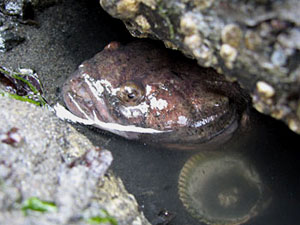Life History and Reproduction
There are two types of male midshipman fish in this species, Type I and Type II. Type I males are classified by their ability to hum or vocalize to attract mates, their size, and their parental behavior. Their ability to vocalize is used in two distinct fashions. First, it is used in mating, the other is used as a warning (Bass, 1990). During mating season, the fish uses a low pitched hum to attract females to its nest, and a warning call to keep other males away. This is accomplished by certain muscles known as drumming muscles near the swim bladder of the fish (Bass, 1990). Type I males dig a nest, which is usually located within the intertidal zone. He will attempt to attract as many females as possible, allowing for multiple clutches of eggs within his nest. The Type I male will guard the nest after the eggs are laid and will continue to guard them until the young are born (Lewis, 2013).
The Type II male is sometimes referred to as a “sneaker”. This
type lacks the ability to hum songs to attract mates, and is
much smaller than its Type I counterpart. It does not guard
nests, or even create them; instead, it will wait near a Type I
male’s nest during mating season and will ‘sneak’ in while the
female is laying her eggs, and quickly fertilize them (Lewis,
2013). The females that are attracted will come to the call of
the Type I male, where they will usually lay more than 100 eggs
(Young Suk et al, 2009).
 They tend to deposit the eggs onto the
undersides or sides of structures, the females are able to do
this because of an adhesive layer around the egg itself. After
depositing the eggs, they will depart and leave the Type I males
to guard the nest. The male midshipmen fish will guard the eggs.
He will fan the eggs and newborns until they become free
swimming, about six weeks after hatching (Fulton-Bennett, 2012)
(Young Suk et al, 2009).
They tend to deposit the eggs onto the
undersides or sides of structures, the females are able to do
this because of an adhesive layer around the egg itself. After
depositing the eggs, they will depart and leave the Type I males
to guard the nest. The male midshipmen fish will guard the eggs.
He will fan the eggs and newborns until they become free
swimming, about six weeks after hatching (Fulton-Bennett, 2012)
(Young Suk et al, 2009).
After the eggs hatch, the larvae stage begins. From this stage, they will remain in the nest until they become free swimming; mostly staying attached to the structure upon which they were laid. They then progress into the free swimming stage and at this point are considered a juvenile fish (Fulton-Bennett, 2013). They will then swim off to deeper water to find homes for themselves. The young fish will begin to prey on small crustaceans and other fish and grow until they are finally adult fish. Young adult sized fish tend to range in between 15.2 centimeters to 20.3 centimeters (about 6 to 8 inches). The max length recorded for Porichthys notatus is 38 centimeters (about 15 inches); and Type I males usually weigh in around .350 kilograms (or just over 3/4 of a pound) (Lee, 2006). These fish will keep feeding until they are sexually mature, however, the time elapsed by each fish is different. The Type I males, due to their greater size take longer, about three and a half years, than the Type II males to mature. After maturity is reached these fish will come back up into the intertidal zone to reproduce and restart the cycle.
Click
here to go back to Nutrition & Physiology
Click
here to go forward to Form & Function
